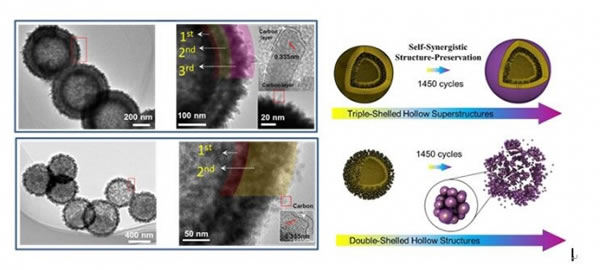Lithium-ion batteries, as one of the major current energy storage technologies, provide the main driving force for emerging portable electronic devices and electric vehicles. In order to meet market demand, the development of high energy density lithium ion batteries with long cycle life and high power is imminent. However, the negative electrode of lithium ion batteries, especially high-capacity anode materials, undergoes large volume expansion/contraction changes in the lithiation/delithiation process, causing severe comminution of the material, resulting in irreversible capacity loss of the battery and also in the cycle performance of the battery. And the rate performance is severely degraded. In order to solve the problem of electrode pulverization, most of the current studies use a graphitic carbon with excellent mechanical properties and good conductivity as a flexible substrate for a negative electrode material. However, the theoretical capacity of graphite carbon (~372 mAh g-1) is low, and the introduction of high-content carbon will greatly reduce the battery capacity and energy density, thus greatly limiting its practical application in electric vehicles. Reducing the carbon content in the negative electrode material is an effective way to increase the energy density. However, it is very challenging to build a negative electrode material with low carbon content and anti-powdering properties. Professor Yang Jinhu's research group at the School of Chemical Science and Engineering of our school is dedicated to the development and application of lithium-ion batteries, actively responding to challenges, and researching key issues.
Recently, the research group has worked closely with Prof. Peng Huisheng of Fudan University to make important progress in the anti-powdering research of lithium ion battery anode materials. Relevant research results were published online in the international material science journal "Advanced Materials" ("Antipulverization Electrode Based on Low-Carbon Triple-Shelled Superstructures for Lithium-Ion Batteries") (2017, DOI: 10.1002/adma.201701494, with an impact factor of On 19.79), Zulianhai, a doctoral student of the research group, was the first author of the dissertation.

The researchers used nano-assembly technology to assemble multiple nanostructured elements (nano-dot and nano-rod) layer-by-layer to form a low-carbon (4.83%) SnO2 tri-shell hollow structure and a high carbon content (35.1%) of SnO2. Double shell hollow structure (above). It was found that the low-carbon three-shell hollow structure can withstand a huge volume expansion rate of up to about 231.8% during lithium insertion, and can still output up to 1099 mAh g-1 reversible capacity even after 1450 cycles; and a high-carbon double shell layer The structure will collapse quickly in the cycle and its performance will be greatly attenuated. In-situ transmission electron microscopy characterization and mechanical simulations show that the three-shell structure has a special self-cooperative structure retention mechanism during lithiated/delithiated lithium, the protective structure does not collapse, and the structure of the electrode material during the long cycle is ensured Integrity. Specifically, the shell layer is fully lithiated during the lithiation process to prevent overlithiation of the inner shell and collapse of the structure; conversely, in the delithiation process, the lower lithiated inner shell acts as a strong core to The huge volume shrinkage stress supporting the shell layer prevents the shell layer from collapsing; at the same time, the middle shell layer with rich pores provides enough space during the lithiating and delithiation processes to adapt to the volume and stress changes of the shell layer. This study opens up new avenues for the development of practical, high-energy lithium-ion batteries.
The study was supported by the National Natural Science Foundation of Shanghai, the Shanghai Oriental Scholars Program, the Tongji University Youth 100 Program, and the Shanghai Innovation Key Project. He was also awarded Professor He Pengfei from the School of Aerospace Mechanics at Tongji University, Professor Chen Kai from Xi’an Jiaotong University, and Zhejiang. Associate Professor Su Qingmei from Normal University, Prof. Yang Shihe from Hong Kong University of Science and Technology, and other research teams have cooperated and supported.
Due to the chemical nature of the hydrofluoroether compound, it is colorless, odorless, non-toxic, environmentally friendly, with a boiling point of 54 degrees Celsius, extremely low surface tension and viscosity, and can be well dispersed and spread into various gaps, with good scouring and wetting. The cleaning effect can be well applied to the cleaning of electronic components, and the electrical insulation is good, and it can be cleaned under the condition of charging, thereby improving the operation space.
Cleaning Solution For Components And Parts
Cleaning Agents,Hexafluoropropyl Methyl Ether Solution,Hfe Cleaning Solution For Parts,Cleaning Solution For Components And Parts
Guangdong Giant Fluorine Energy Saving Technology Co.,Ltd , https://www.tuwtech.com
